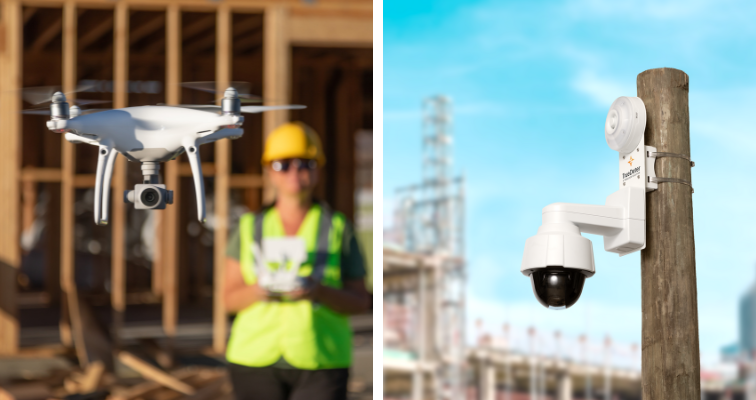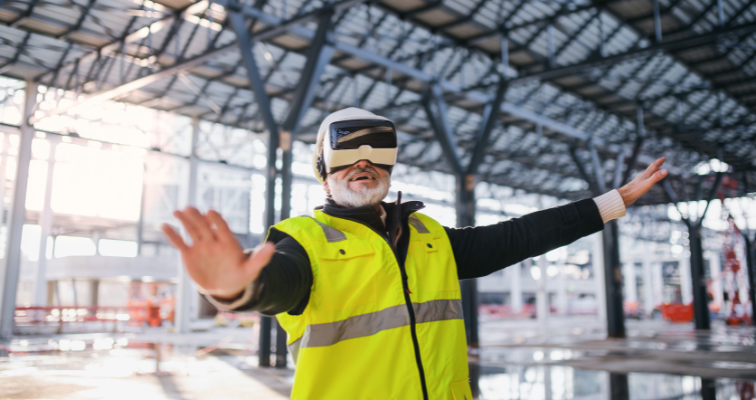Imagine stepping onto your construction sites and seeing technology that belongs in a sci-fi film rather than another average workday. Just a handful of years ago, project managers wrestled with clipboards, manual timekeeping, and gut-instinct scheduling.
Today’s construction landscape looks more like that sci-fi movie every day as groundbreaking technology rewrites the rules of how we build. From drones that inspect nearly impossible-to-reach areas to construction cameras armed with artificial intelligence to prevent theft, construction tech is evolving at a rapid pace.

Promising construction technology trends suggest we have new tools to solve pain points like labor shortages, sustainability demands, and increasingly complex project requirements. Recognizing these trends allows construction firms to stay ahead of the competition, which is why we created this article to highlight the key developments shaping the industry.
The Driving Forces Behind Construction Technology Trends
Change happens because of any number of factors and can befall any industry, including construction. Despite familiar overtones, many of these factors have specific implications for construction sites and project managers, such as:
- Labor Shortages: In 2024, the construction industry was 500,000 workers short of demand. Shortages across the board, from skilled labor to back office professionals, have business owners turning to automation and AI to help existing staff complete larger workloads with fewer resources.
- Sustainability Goals: Local and national governments have a wide range of environmental sustainability goals. These green initiatives force construction firms to adopt new procedures and materials. Advanced sustainable construction technology and eco-friendly equipment help construction managers meet emerging requirements.
- Increased Complexity of Projects: Buildings are getting smarter by the day, increasing their construction complexity. New tools, like AI-enabled cameras, 3D modeling, and automation software, simplify the growing complexities into manageable steps. These tools adapt to real-time data, adjusting everything from inventory to scheduling to match project needs.
- Cost Management and Efficiency: The new technology that aids construction professionals with the growing complexity of projects also helps manage costs and enhance efficiency. Those aforementioned software platforms reduce waste through data-driven resource allocation and trend-based scheduling.
We’re experiencing a technological explosion unlike anything since the dawn of the internet. Developers, construction companies, and real estate professionals are capitalizing.
Emerging Technologies to Watch in Construction
As of right now, most of the AI automation is somewhat limited, taking care of back-office tasks more than framing a house. However, that doesn’t mean you can’t take advantage of some other emerging technologies that can help you and your skilled workforce get more done at a higher quality. Those technologies include:
- Advanced Robotics: Driverless excavators, concrete pouring robots, and drones—say it ain’t so. Well, actually, these new toys allow laborers to reach untapped or dangerous locations and unlock new or exotic materials. These machines also remove the need for painfully repetitive tasks, saving your back for another day.
- Augmented Reality (AR) and Virtual Reality (VR): Where 3D CAD rendering software creates digital buildings, AR and VR allow you to walk around those virtual spaces. These immersive experiences can reveal potential roadblocks or design flaws before they become costly hangups. AR and VR also provide interactive, hands-on training, helping to close the skills gap without costly or time-consuming courses.
- Digital Twin Technology: To create VR and AR virtual spaces, project managers must create a digital twin. These digital twins virtualize real-world spaces so that AI and machine learning can optimize inventory, scheduling, and progress milestones.
- Energy-Efficient Technologies: Modern construction is embracing advanced energy-efficient materials to reduce environmental impact and improve performance. For example, aerogel insulation offers superior thermal resistance with less material, self-tinting glass reduces HVAC loads by adjusting to sunlight, and phase-change materials (PCMs) help regulate indoor temperatures by storing and releasing heat. These innovations make high-quality builds more efficient while lowering long-term energy costs.

Other tech, such as AI-driven construction cameras, bring oversight to jobsites that were not available previously. They can identify vehicles and head counts, which is perfect for limiting access to your sites to only those who belong there.
How Construction Technology is Changing Jobsite Management
Technology moves many industries forward, especially as more businesses adopt some of the most exciting advancements. In fact, many construction firms, just like yours, are adopting jobsite management tech that makes it easier to keep projects on track and within budget.
Here’s how construction companies are putting technology to good use:
- Real-Time Data and Monitoring: Construction cameras give you a 24/7 view of your sites, wherever you are. TrueLook’s live-viewing and time-lapse tools improve decision-making and project oversight. Videos captured during construction are also prime marketing tools, showcasing your capabilities.
- IoT Integration: Internet of Things (IoT) sensors track materials, equipment, and environmental conditions, automatically coordinating building plans, inventory, and schedules. These sensors also provide equipment with GPS tracking functions, making them more recoverable in the case of theft.
- Mobile Apps for Field Teams: Managers on the construction site rarely have access to computers. Mobile apps unlock computing features, seamless communication, and task management between field teams and office staff. Construction tools, like cameras, connect with apps to monitor every project while on the move.
- Wearable Tech for Safety: Wearable devices enhance worker safety and productivity by tracking PPE usage and providing insights into what tasks workers are engaged in throughout the day, helping improve site efficiency and coordination. Wearable tech even tracks when workers get fatigued and need to take a break before an accident happens.
Long-Term Opportunities of Construction Technology
Although we currently deploy advanced technology on the jobsite, there are even more exciting solutions still in development. These construction tools promise even faster turnaround times, fewer resources, and better results than current methods:
- Autonomous Construction Sites: Robotic, AI-powered workers will automate repetitive construction processes and dangerous tasks. They also open the door for unique building materials and methods that result in higher-quality construction and lower costs.
- AI-Driven Predictive Maintenance: AI trending and IoT sensors will predict equipment failures and optimize maintenance schedules. Optimized maintenance and replacement keeps expenses down while maximizing the usable life of equipment.
- Sustainability as Standard Practice: Sustainable construction tech will become a necessity, not a luxury, especially as commercial and regulatory restrictions tighten. Green equipment and building practices will become standard practice, but technology will make the transition seamless.
- Globalization of Construction Technology: Globalization means specialized tools, construction materials, and international contracts. Even the American Bar Association (ABA) has guidelines on performing such work, and technology will only make securing global connections easier.
How to Stay Ahead of Construction Technology Trends
As construction companies navigate an increasingly complex technological landscape, staying competitive requires a strategic approach to adopting and integrating cutting-edge technologies.
You can adopt some of these strategies today and create a tech-forward construction environment:
- Invest in Scalable Solutions: Migrate to cloud-based solutions for software that stays up to date. These solutions also scale when you need them, and providers handle the back-end maintenance. Plus, you save money up-front, thanks to the subscription model most providers use.
- Partner with Tech Leaders: Partner with industry leaders when adopting technology. For example, TrueLook offers advanced jobsite monitoring and data solutions, while a tool like Procore manages your back office paperwork.
- Emphasize Continuous Learning: 63% of construction employers are upskilling and reskilling staff to meet labor shortages and shifting construction industry trends. To go with that statistic, 71% of workers report higher job satisfaction upon learning a new skill, which makes continuous learning a win-win for you and your team.
- Leverage Industry Events and Networks: Stay informed with emerging and evolving trends by attending conferences and engaging with industry groups. Add magazines, such as Builder Magazine and ConstrucTech, to your reading list to expand your awareness.
Adopting Innovation: The Future of Construction is Now
The construction sector is at a pivotal moment where technological advancements are reshaping construction management, project efficiency, jobsite safety, and building practices. Current construction technology trends reveal professionals embracing these advancements to better meet deadlines, manage cost overruns, and satisfy clients.
Future breakthroughs in artificial intelligence, advanced data analytics, and interactive technologies will make complex construction projects easier to build. We’ll see automation take on more challenging, dangerous, and repetitive tasks, saving our knees and backs in the process.
Ready to build your next-gen construction site?
TrueLook offers advanced construction cameras and security solutions to provide unparalleled project oversight and criminal deterrence.

